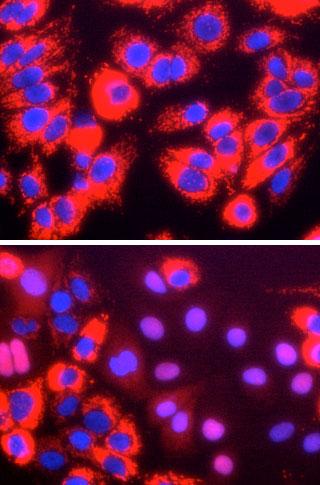Expression of a single gene lets scientists easily grow hepatitis C virus in the lab

Researchers engineered cultured cells to contain a red marker that moves into the nucleus upon HCV infection. Nothing happened when normal cells were exposed to HCV (top), but when the researchers expressed the protein SEC14L2, some nuclei changed color from blue to purple (bottom). Credit: Laboratory of Virology and Infectious Disease at The Rockefeller University/Nature
In a study published in Nature on August 12, scientists led by The Rockefeller University's Charles M. Rice, Maurice R. and Corinne P. Greenberg Professor in Virology and head of the Laboratory of Virology and Infectious Disease, report that when they overexpressed a particular gene in human liver cancer cell lines, the virus could easily replicate. This discovery allows study of naturally occurring forms of hepatitis C virus (HCV) in the lab.
“Being able to easily culture HCV in the lab has many important implications for basic science research,” says Rice. “There is still much we don't understand about how the virus operates, and how it interacts with liver cells and the immune system. “
Scientists have long attempted to understand what makes HCV tick, and in 1999 a group of German scientists succeeded in coaxing modified forms of the virus to replicate in cells in the laboratory. However, it was soon discovered that these forms of the virus were able to replicate because they had acquired certain “adaptive” mutations.
This was true for the vast majority of all samples from patients, except one, and left scientists with a puzzling question for more than a decade: What prevents non-mutated HCV from replicating in laboratory-grown cell lines? Rice and colleagues hypothesized that one or more critical elements might be missing in these cell lines.
To test this idea, they screened a library of about 7,000 human genes to look for one whose expression would allow replication of non-mutated HCV. When the scientists expressed the gene SEC14L2, the virus replicated in its wild-type, non-mutated form. Even adding serum samples from HCV-infected patients to these engineered cell lines resulted in virus replication.
“Practically speaking, this means that if scientists want to study HCV from an infected patient, it's now possible to take a blood sample, inoculate the engineered cells, and grow that patient's form of the virus in the lab,” says first author Mohsan Saeed, a postdoc in Rice's laboratory.
It's not entirely clear how the protein expressed by SEC14L2 works, says Saeed, but it appears to inhibit lipids from interacting with dangerous reactive oxygen species, a process that prevents HCV replication.
Recent advances in HCV treatment have made it possible for millions of people to be cured of the virus. “New therapies, however, are extremely expensive and not perfect,” Saeed notes. “As more patients are treated, drug resistant forms of HCV are emerging. Having a cell culture system where patient isolates can be grown and tested for resistance or susceptibility to alternative antiviral drug combinations should be useful for optimizing re-treatment strategies for those that fail treatment.”
Even though effective therapies for HCV do exist, there is still much we need to understand about the virus, adds Saeed — and understanding how HCV interacts with its host cell can help scientists learn more about similar viruses for which effective treatments have yet to be developed. “The lessons learned from one disease can be true for other diseases as well,” he observes.
Media Contact
All latest news from the category: Health and Medicine
This subject area encompasses research and studies in the field of human medicine.
Among the wide-ranging list of topics covered here are anesthesiology, anatomy, surgery, human genetics, hygiene and environmental medicine, internal medicine, neurology, pharmacology, physiology, urology and dental medicine.
Newest articles

NASA: Mystery of life’s handedness deepens
The mystery of why life uses molecules with specific orientations has deepened with a NASA-funded discovery that RNA — a key molecule thought to have potentially held the instructions for…

What are the effects of historic lithium mining on water quality?
Study reveals low levels of common contaminants but high levels of other elements in waters associated with an abandoned lithium mine. Lithium ore and mining waste from a historic lithium…

Quantum-inspired design boosts efficiency of heat-to-electricity conversion
Rice engineers take unconventional route to improving thermophotovoltaic systems. Researchers at Rice University have found a new way to improve a key element of thermophotovoltaic (TPV) systems, which convert heat…



